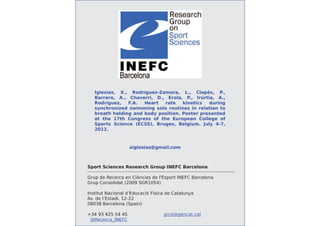
HEART RATE KINETICS DURING SYNCHRONIZED SWIMMING SOLO ROUTINES
- 1. ! " # $ " " %& "' & (&' & ) & "& & " & " * " && * ( " & " &" " " +," & - " & - . " .' &' / ..0 1 ( 2 , 34+3 . " .' &' ' 5 6 # ' & ! " # $ % &'( " ) * + ,+ ! -, , . /. ( / 0
- 2. HEART RATE KINETICS DURING SYNCHRONIZED SWIMMING SOLO ROUTINES IN RELATION TO BREATH HOLDING AND BODY POSITION Iglesias X.1, Rodríguez-Zamora L.1, Clapés P. 1, Barrero A. 1, Chaverri D.1, Erola P.2, Irúrtia A .1, Rodríguez F.A.1 1INEFC-Barcelona Sport Sciences Research Group, Institut Nacional d’Educació Física de Catalunya, Universitat de Barcelona (Barcelona, Spain) 2DEIM, Universitat Rovira i Virgili (Tarragona, Spain) Supported by CSD (001/UPB10/11) and ICD (U-34/10) grants Introduction & Aim Figure 1. Heart rate response during a solo routine related to breath holding (i.e. Discussion face-in vs. face-out) in an Olympic medalist Performance times for synchronized swimming (SS) solo routines range from This is the first study in which the cardiovascular response related to breath 2 min for the technical solo (TS) to 3min for the free solo (FS) (FINA rules holding and body position has been examined during a SS competition. We 2009-2013). Homma (1994) found that, on the average, 62.2% of this time is found that: spent underwater, while Alentejano et al. (2008) reported a lower value (46%). Bradycardic events occur while swimmer is holding breath (FI) or breathing It is known that synchronized swimmers experience diving bradycardia during (FO), in line with results by Gemma et al. (1987) who observed bradycardic breath holding (BH) bouts underwater (Gemma & Wells 1987, Rodríguez- episodes in ten synchronized swimmers while performing six SS figures Zamora et al. 2012). during training This study aims to determine the frequency and duration of face The diving response appears to be powerful enough to override the immersion periods in relation with body position, and to characterize chronotropic HR response to intense exercise during dynamic apnea heart rate response in technical and free solo routines Time spent FI was 3% higher in TS than in FS. This could be explained by the higher number of figures performed during free, since FS routines allow Materials & Methods more variety of movements to demonstrate grace, artistry and creativity, as there are no figure requirements Eight elite synchronized swimmers (20.8 ± 4.9 years, 3 Olympic medalists) Average immersion time (62.1%) are in full agreement with results reported were monitored while performing a total of 11 routines during an official Table 1. Heart rate parameters during solo routines in relation to breath holding by Homma et al. (1994) who observed that top international swimmers national championship in the technical solo (TS, n=5) and free solo (FS, n=6) and body position during solo routines spent 62.2% of the time immersed, clearly higher than programs. Heart rate (HR) was continuously monitored using a waterproof HRmean HRsd HRmax HRmin % 46% reported by Alentejano et al. (2008). beat-by-beat monitor (Cardio Swim, Freelap, Switzerland). All routines were recorded using a digital video camera (Panasonic 3-CCD Mini-DV Whole routine 152,3 30,6 205 20 100 Camcorder) at 50 Hz and 50 frames·s-1 with an interlaced resolution of Face-In 150,1* 31,7 205 20 62,1 Conclusions 720x576, allowing a time resolution of 0.102 s. By frame-by-frame video Face-Out 156,1 28,0 201 25 37,9 The autonomous nervous system plays a fine tuned regulation of HR analysis, two face immersion conditions (face-in and face-out; or FI, FO), and in this unique type of exercise in which sympathetic and Horizontal 156,0‡ 27,6 205 23 27,9 three body positions (horizontal, upright, and inverted position; or HP, UP, IP) parasympathetic activation and inhibition are continuously were identified and timed. Inverted 147,4 33,6 200 20 40,5 interplaying according to the swimmer’s body position, breath Upright 155,2 28,1 201 25 31,5 holding condition, and intense exercise Values are beats·min-1 and %. Significant differences (p<0.05) are: *Face-In vs. Face-Out (Wilcoxon two- Results sample test); ‡Horitzontal vs. Inverted and Upright position (Kruskal Wallis test). Our main finding is that the main cardiovascular response to face immersion (i.e. bradycardia) is powerful enough to counteract Mean HR during the 11 solos was 152.3 ± 30.6 beats·min-1. HR peak was exercise tachycardia during the breath holding phases of intense 190.0 ± 13.2 beats·min-1 with frequent interspersed bradycardic events down Table 2. Frequency and duration of face-in immersions during free and technical exercise to 80.7 ± 31.3 beats·min-1. Swimmers were FI 62.1 ± 3.6% of total time, and solo routines FO for the rest (37.9 ±3.6%). Mean HR values during FI was lower (150.1 ± Mean SD Maximum Minimum References 31.7) than during FO (156.1 ± 28.0) (p<0.0001). HR range during the whole routine was 109.4 ± 27.3. Mean HR at HP (156.0± 27.6) was higher (p<.0001) Number of immersions 24,5 8,9 41,0 13,0 Homma M. (1994). Med Sport Sci 39, 149-154 Alentejano TC et al. (2010). Res Sports Med 18(2), 97-114 than at UP (155.2 ± 28.1) and IP (147.4 ± 33.6). Figure 1 shows the HR Time immersed 4,3 1,2 6,2 2,6 Gemma KE et al. (1987). Phys Sportsmed 15(10), 99-106 profile during a solo routine on a swimmer. Table 1 presents descriptive Gabín B et al. (in press). Procedia Computer Science Technology Longest immersion 21,7 4,4 27,8 16,0 values of FI (breath holding) period during solos. Rodríguez-Zamora et al. (2012) ECSS Annual Congress, Brugges, Belgium Presented at the 17th Annual Congress of the ECSS –July 4-7 2012 – Brugges, Belgium
